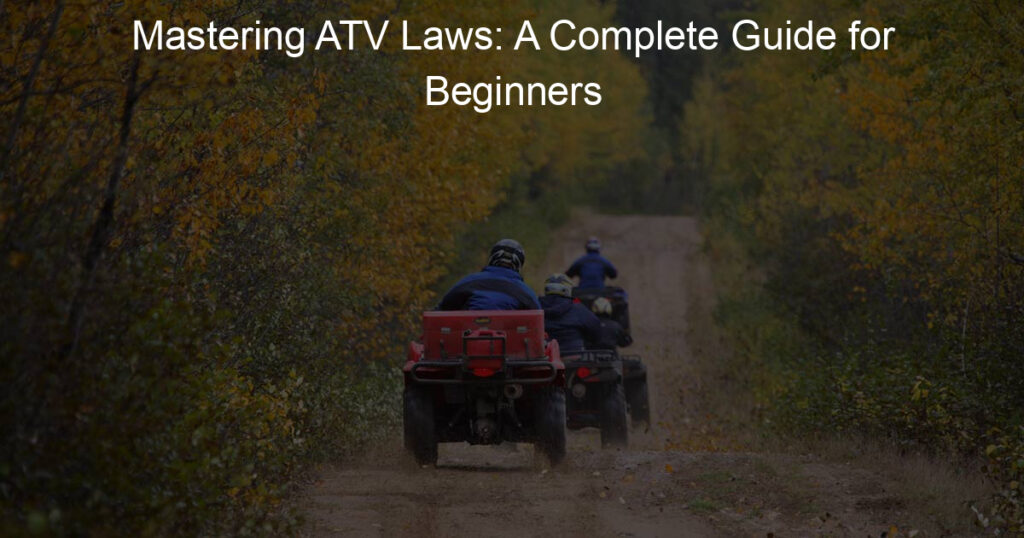
Introduction to ATV Riding for Beginners
Welcome to the exciting world of All-Terrain Vehicle (ATV) riding! This guide is designed to help beginners like you understand the basics of ATV riding and the importance of knowing ATV laws and regulations. Let’s dive in!
- Understanding the Basics of ATV Riding
- Importance of Knowing ATV Laws and Regulations
ATV riding is not just about hopping on a four-wheeler and hitting the trails. It’s a sport that requires knowledge, skills, and a respect for the machine you’re riding. You need to understand how to operate the ATV, how to navigate different terrains, and how to ride safely. For instance, always remember to wear a helmet, keep your speed under control, and never ride under the influence of alcohol or drugs.
Just like driving a car, riding an ATV comes with its own set of laws and regulations. These rules are designed to keep you and others safe. They can vary from state to state, so it’s crucial to familiarize yourself with the laws in your area. Some common ATV laws include age restrictions, helmet requirements, and rules about where you can ride. Ignorance of these laws can result in hefty fines or even the suspension of your riding privileges, so it’s worth taking the time to learn them.
ATV riding can be a thrilling and rewarding hobby, but it’s important to approach it with the right knowledge and respect. By understanding the basics of ATV riding and the laws and regulations that govern it, you can ensure a safe and enjoyable experience. So gear up, ride safe, and have fun!
Comprehensive ATV Laws
Understanding the laws surrounding All-Terrain Vehicles (ATVs) is crucial for safety and legal reasons. In this section, we will delve into the general ATV laws that apply in most states. These laws primarily focus on age restrictions, helmet and safety gear requirements, and ATV size and power limitations.
General ATV Laws
Here are some of the most common ATV laws that you should be aware of:
- Age restrictions
- Helmet and safety gear requirements
- ATV size and power limitations
Most states have age restrictions for ATV riders. Typically, children under the age of 16 are not allowed to operate an ATV. However, some states allow children as young as 10 to ride ATVs under the supervision of an adult. It’s crucial to check the specific age restrictions in your state.
Wearing a helmet and safety gear is a must when riding an ATV. This includes gloves, long pants, and boots that cover the ankles. Some states also require riders to wear eye protection. Remember, these safety measures are not just legal requirements—they can save your life.
ATVs come in various sizes and power levels. Most states have laws that limit the size and power of the ATV based on the rider’s age. For example, a child under 16 might be restricted to an ATV with an engine size under 90cc. Always ensure the ATV you are riding is appropriate for your age and experience level.
These are just a few of the general ATV laws. It’s important to remember that laws can vary from state to state, so always check the specific laws in your area before riding an ATV.
ATV Laws by State
Each state in the U.S. has its own set of rules and regulations for ATV riding. Let’s take a closer look at the ATV laws in California, Texas, and Florida.
-
Unique ATV laws in California
In California, ATV riders under 18 years old must complete an approved safety course and carry the safety certificate with them while riding. Additionally, all riders, regardless of age, are required to wear a helmet. Riding on public streets is generally not allowed, except to cross these roads. However, there are certain exceptions for rural areas.
Age Requirement Under 18 must complete safety course Helmet Requirement Mandatory for all ages Riding on Public Streets Generally not allowed -
ATV regulations in Texas
Texas law requires all ATV riders to wear a helmet if they are under 14 years old. ATVs are not allowed on public roads, except for agricultural purposes or crossing roads. Riders under 14 must be supervised by a person who is at least 18 years old.
Age Requirement Under 14 must be supervised Helmet Requirement Mandatory for under 14 Riding on Public Streets Not allowed, except for agricultural purposes -
Understanding ATV laws in Florida
In Florida, ATV riders under 16 years old are required to wear a helmet and eye protection. ATVs are not allowed on paved public roads. However, they are allowed on private property with the owner’s permission.
Age Requirement Under 16 must wear helmet and eye protection Helmet Requirement Mandatory for under 16 Riding on Public Streets Not allowed on paved roads
Remember, these laws are in place to ensure your safety and the safety of others. Always follow them when riding an ATV.
ATV Safety Regulations
When it comes to ATV riding, safety should always be your top priority. This section will cover essential safety regulations that every ATV rider should follow to ensure a safe and enjoyable ride.
Equipment Safety
Proper equipment is the first line of defense in ATV safety. It’s not just about having the right gear, but also ensuring that it’s in good condition and used correctly. Let’s explore the two main aspects of equipment safety:
- Helmet and Protective Gear
- Vehicle Maintenance and Inspection
Wearing a helmet is not just a safety regulation, it’s a lifesaver. According to the Centers for Disease Control and Prevention, helmets can reduce the risk of head injuries by 69% and the risk of death by 42%. Always wear a helmet that fits well and meets the Department of Transportation (DOT) standards. Other protective gear includes gloves, boots, long pants, and a long-sleeved shirt. These items protect you from cuts, scrapes, and burns.
Regular maintenance and inspection of your ATV are crucial for safe riding. Always check the tires for proper inflation and look for any signs of wear or damage before each ride. Ensure the brakes are working correctly, and the lights and signals are functioning. Regular oil changes and air filter checks are also essential to keep your ATV in top shape. Remember, a well-maintained ATV is a safe ATV.
In conclusion, adhering to ATV safety regulations not only ensures your safety but also enhances your riding experience. Always remember, safety first!
Riding Safety
When it comes to ATV riding, safety is paramount. Let’s delve into some safe riding techniques and common hazards you should be aware of.
- Safe Riding Techniques
- Stay in Control: Always ride at a speed that allows you to react quickly to unexpected obstacles.
- Use both hands and feet: Keep both hands on the handlebars and both feet on the footrests at all times. This helps maintain balance and control.
- Ride on Designated Trails: Stick to designated ATV trails. They are designed to minimize hazards and are maintained for safe riding.
- Common Hazards and How to Avoid Them
- Uneven Terrain: Always scout ahead for changes in the terrain such as bumps, holes, or slippery surfaces. Slow down and approach these areas with caution.
- Wildlife: Animals can suddenly appear on trails. If you see an animal, slow down and give it space to move away.
- Other Riders: Always keep a safe distance from other riders. This gives you enough time to react if they make sudden moves.
Practicing safe riding techniques is the first step towards ensuring your safety on an ATV. Here are some tips:
Being aware of common hazards can help you avoid accidents. Here are some common hazards and how to avoid them:
In conclusion, practicing safe riding techniques and being aware of common hazards can greatly enhance your safety while riding an ATV. Remember, safety should always be your top priority.
Beginner’s Guide to ATV Riding
Welcome to the world of ATV riding! This guide is designed to help beginners understand the basics of ATV riding and make the right choices. Let’s dive in!
Choosing the Right ATV
Choosing the right ATV is the first step towards a safe and enjoyable riding experience. Here are some key points to consider:
- Understanding different types of ATVs
- Choosing an ATV based on your needs and skill level
- Starting and stopping
- Turning and maneuvering
- Case Study 1: ATV laws violation and its consequences
- Case Study 2: The impact of following ATV safety regulations
- Key takeaways: The importance of understanding and following ATV laws
- Final thoughts: Becoming a responsible and safe ATV rider
ATVs come in various types, each designed for specific uses. There are sport ATVs, utility ATVs, and youth ATVs. Understanding the differences between these types can help you choose the right one for your needs.
Consider your skill level and the intended use of the ATV. For beginners, a less powerful ATV is recommended. As you gain experience, you can upgrade to a more powerful model.
Learning how to properly start and stop your ATV is crucial. Always start your ATV with the engine off and your foot on the brake. To stop, gradually apply the brakes until the ATV comes to a complete stop.
Mastering turns and maneuvers is essential for safe ATV riding. Practice turning at slow speeds before attempting faster turns.
Consider the case of a rider who violated ATV laws by riding without a helmet. The rider suffered severe injuries when he lost control of his ATV. This case underscores the importance of following ATV laws for your safety.
In contrast, consider a rider who always followed ATV safety regulations. Despite several falls, the rider sustained minor injuries thanks to his protective gear. This case shows the positive impact of following safety regulations.
Understanding and following ATV laws is not just about avoiding penalties. It’s about ensuring your safety and the safety of others. Always wear a helmet, follow speed limits, and never ride under the influence of alcohol or drugs.
Becoming a responsible and safe ATV rider involves more than just learning how to ride. It involves understanding the risks, making the right choices, and always prioritizing safety. Remember, the thrill of ATV riding comes with responsibility. Enjoy the ride, but always stay safe!














